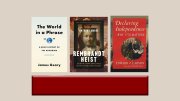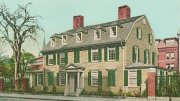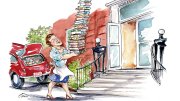In1937, John Maynard Keynes had a serious heart attack. His British doctors more or less gave up on him and prescribed indefinite bed rest. But somehow Keynes heard of an émigré physician, Janos Plesch. This was before penicillin, but Plesch was able to prescribe Prontosilthe first of the sulfa drugs. God knows where he got it. The drug enabled Keynes to lead a fairly normal life. If Plesch was something of an enigma to Keyneswho later described him as "something between a genius and a quack"his name is familiar to those of us who have studied the life of Albert Einstein: he was the dying physicist's last nonfamily visitor. Einstein agreed with Keynes, yet he and Plesch had an affectionate friendship that lasted for decades.
 |
| Plesch with a few of the people in his life. |
| Photomontage by Bartek Malysa. Primary art reproduces the images on the dust jacket of Plesch's autobiography; the works came from Plesch's own collection and the portrait of Einstein was painted by Plesch himself. The photographs of Plesch with his son, Peter, and with Marlene Dietrich are reproduced courtesy of Peter Plesch. |
Plesch was born in Budapest to a middle-class Jewish family, many of whom were doctors. His own parents were not well off, but he determined to be a physician and at 16 enrolled in medical school. By his early twenties he had his own clinic at a fashionable spa, Rajecz-Teplitz. His 1949 autobiography, Janos: The Story of a Doctor (which he signs "James Plesch") ignores dates, including those of his birth and marriage, but indicates it was there that he began collecting people both as patients and friends. If we can believe his autobiography, he knew everybody. Before World War I he had moved to Berlin and in 1917 married into a well-to-do Jewish family, the Ganses, who owned one of the companies that merged to become I.G. Farben. This, plus his very successful practice, enabled him to live in a spectacular mansion and on a country estate where Einstein visited frequently. Plesch was in the habit of giving Herrenabendsstag nightswhere the likes of Arthur Schnabel and Fritz Kreisler, as well as prominent painters, writers, and diplomats, were treated to a magnificent dinner and lively conversation. Einstein was a prize guest. He soon became a patient.
Einstein was suffering from what Plesch diagnosed as pericarditusan inflammation of the membranous sac that encloses the heartfor which Plesch prescribed bed rest, a salt-free diet, and diuretics. He wavered about telling Einstein to stop smoking. The conventional medical establishment in Berlin was outraged that Einstein would become the patient of a man whom they regarded as a fashionable charlatan. Einstein, who recovered because of, or despite, Plesch, seemed somewhat amused by the whole affair, remarking amiably, "He is a swine, but he's my friend."
After the Nazi takeover in 1933, Plesch and his family left for England. He somehow arrived with enough money to send his son, Peter, to Harrow and then Cambridge, but he himself had to go to medical school all over again, in his mid fifties, to get a license to practice. Nevertheless, his reputation was such, he claims, that the office opening was "something of an event." He at once began collecting peoplefrom George Bernard Shaw to Sir Thomas Beecham. Keynes must have come along in the mix. The two men kept up a considerable correspondence in which Keynes described the state of his various ailments and sometimes those of others: in 1941, on a trip to the United States, he wrote that he had found Einstein in bed with gall-bladder trouble and added, "I expect you will be saying that it is all because you were not there to insist on his keeping a proper diet in the spring of the year."
By 1951, Plesch had decided that England was too dull"It is not a life, it is vegetation"so he and his wife moved to Switzerland. After she died, in 1954, he moved in with her surviving sister in Mill Valley, California. He was visiting friends in Beverly Hills when he had a sudden heart attack and died.
Almost 40 years later, Peter Plesch, a physical chemist now living in active retirement in England, published some of his father's reminiscences of Einstein, including his medical analyses. Some of the latter are truly bizarre. Given the proximate cause of Einstein's deatha ruptured abdominal aneurysmPlesch, who had not treated the scientist since the early 1930s, decided, based on his "long medical practice," that Einstein must have been suffering from syphilis. I am not a physician but I would put this in the same category as the adviceprovided in an appendix to his autobiographyto expose young children to tanning machines in order to prepare them for exposure to the sun.
Einstein biographers, indeed, usually emphasize the "crank" side of Plesch, but he was a genuine researcher as well as a boulevardier and dandy with a love of the good life: in 1906 he may have been the first person to use what is now known as paper-chromatography of bile pigments. He focused on blood pressure and heart functions, about which he wrote two standard texts; during World War I he flew in observation planes to measure the blood pressure of aviators, and he was in contact with R.A.F. doctors during World War II. The range of his publications is quite astounding. One reason his father and Einstein got along so well, Peter Plesch told me, is that they were equally curious about each other's specialties. A biographer prays for a contemporary witnesseven with flawswho sees the subject in his or her bedroom slippers. In this respect, who could be closer, spouses excluded, than a doctor and friend?
Physicist and former New Yorker staff writer Jeremy Bernstein '51, Ph.D. '55, is the author of biographies of Einstein and Hans Bethe, among many other works for scholarly and lay readers.





